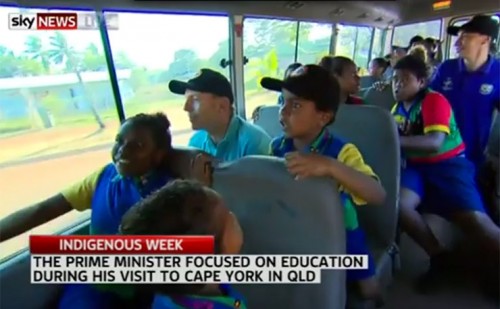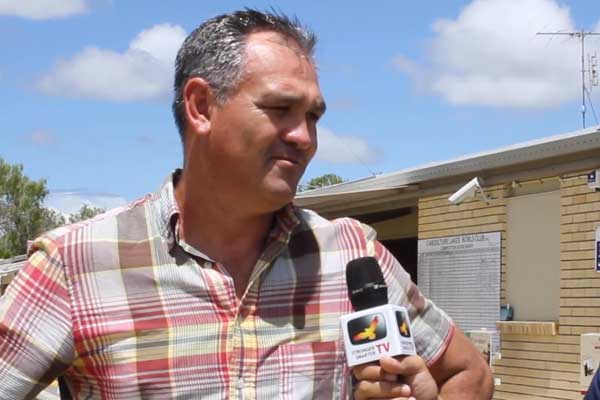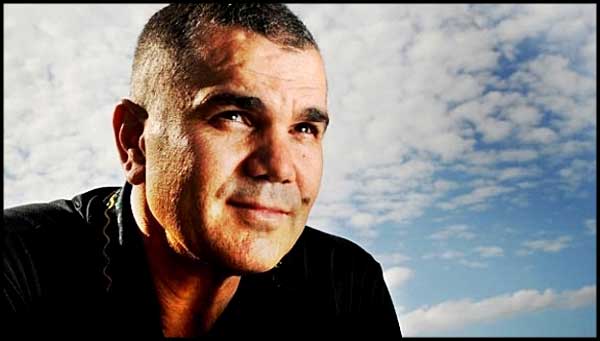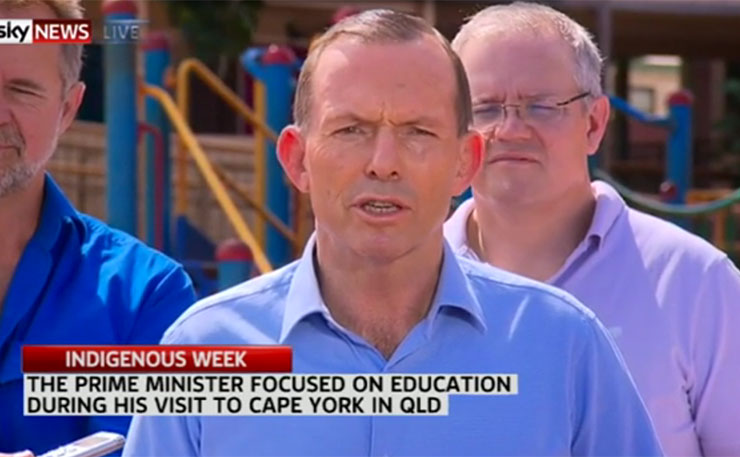Prime Minister Tony Abbott unwittingly sang the praises of a celebrated Aboriginal-devised teaching method while on his trip to Bamaga this week, while his government continues to refuse to fund its expansion.
In pictures and footage beamed across the country from the tiny Cape York community, Mr Abbott accompanied a bus full of students rounded up by his truancy officers, employed as part of his remote school attendance strategy, and toured the classrooms of the Bamaga school, where he was impressed by the “sophisticated” teaching method on display.
According to Abbott, “many schools in remote parts of Australia are being transformed right now by better forms of teaching, by a renewed focus by all governments on putting the best teachers into remote schools and I think we saw palpable enthusiasm in these classrooms”.
His assistant education minister – Senator Simon Bermingham – was quick to link the school’s success in attendance rates, which had hovered around the 70 per cent mark, to the Abbott government’s focus on truancy, and the controversial Direct Instruction (DI) teaching method.
The remote school attendance strategy was rolled out in selected communities last year, and involves school attendance officers employed to help round up kids to school each day.
As of last year, the remote attendance strategy had attracted about $46 million in federal funds, and is a key plank of Abbott’s three-pronged approach to Aboriginal affairs – getting kids to school, adults into jobs, and making communities safe.
Another focus of the Abbott government is the rollout of Direct Instruction (DI), which has been trialled in three sites under the Cape York Welfare Reform Trials, devised by Cape York lawyer Noel Pearson. The trials have attracted nearly $150 million in federal and Queensland government funds, but have not been transparent on outcomes.
DI is currently being taught in three Cape York Aboriginal Academy Schools – Aurukun, Hope Vale and Coen.
Because success stories are so scarce in government funded programs in the Cape, Abbott this week sought to take full advantage of the outcomes from the Bamaga School, telling journalists that this success could be attributed to the explicit and direct instruction supposedly on display in classrooms.
“Certainly we did see a form of explicit and direct instruction in these classrooms today and as someone who has been in Indigenous classrooms at different times over quite a few years now, they were the best classrooms I’ve ever seen and most of these classrooms have a very high percentage of people attending,” he told journalists.

Abbott also tied the school’s “sophisticated” teaching method, to the Aurukun school trialling DI under Pearson’s welfare reforms.
“As you might remember, I spent three weeks as a teacher’s aide in Coen back in 2008. I spent 10 days as an attendance officer in Aurukun back in 2009,” he said.
“I saw the beginnings of this transformation in 2012 in Aurukun, where more Direct Instruction methods were already being applied. But what we saw was a very sophisticated teaching method, based on the things that we know work, based on, if you like, traditional teaching methods, but a much more sophisticated version of it…”
There’s only one problem: Noel Pearon’s Direct Instruction is not being used in Bamaga.
Direct Instruction is a 1960’s style teaching method imported from teh US, which involves teachers following carefully scripted lesson plans. It has an off-shoot – Explicit Direct Instruction.
The Bamaga School does use Explicit Instruction – which is a teacher-focused instruction technique focusing on goals and outcomes. Even then, it is only used in some classes and year-levels.
While Bamaga doesn’t use DI, what it has done is employ the Stronger Smarter technique, devised by celebrated Aboriginal educator Dr Chris Sarra. That has come in the form of the Aboriginal principal – Yolanda Coutes – who has a long history in remote education, and has been directly involved in the Institute’s courses since 2009.
At least three or four teachers on her staff have also been trained by Stronger Smarter.
Head of the school’s P&C, Richard McLean told the ABC’s Anna Henderson that it was disappointing the Prime Minister had misrepresented the effort put in by teachers and Ms Coutes.
“They put in a huge effort, the parents and the students who are innocent in all this. For that praise to go somewhere else I think was unfair. Maybe (Abbott) hasn’t done his homework.”
CEO of Stronger Smarter Darren Godwell told New Matilda today Explicit Instruction was just one of the elements that fit into the institute’s frameworks, and had led to the success at the school.

“In Bamaga, explicit instruction is rolled out in some classrooms in some years, but it’s part of the package. All of those elements fit into the framework of the Stronger Smarter approach,” Mr Godwell told New Matilda.
“This is how we create the change. We actually have faith and believe in the educators as being professionals to come up with an appropriate response to achieve better education outcomes,” Mr Godwell says.
“The deficit thinking is about shifting blame. And what happens is that first, the students are the problem, the teachers are then the problem, then the system is the problem.
“When in fact we need a strength-based approach. We need to look at the assets, and the advantages. That is a radical shift.”
But it goes much deeper than Abbott simply wrongly attributing the success to a Pearson-backed programme never in operation at the school.
While the success of the Stronger Smarter method is reflected in its outcomes, the institute missed out on funding to roll out its programmes under the Abbott government’s chaotic Indigenous Advancement Strategy (IAS).
The institute applied for $30 million in federal funding over three years to roll out its programmes across the country, reaching up to 100,000 kids.
But the federal government’s focus on remote schooling was one of the reasons it was knocked back.
Stronger Smarter doesn’t just focus on remote schools.
“70 per cent of our population live in regional centres and metro centres, and there are three growth corridors – Brisbane, Western Sydney and the North Coast,” Mr Godwell says.
Rolling out the programme across the country is an attempt to reach the next generation of Aboriginal students from the “black baby boom that’s coming through”.
“There is urgency…. The leading edge of that population bubble reaches school on January 2018. We have to get as many schools Stronger Smarter before that date,” Mr Godwell says.
In contrast, while Stronger Smarter was knocked back for $30 million, despite the Prime Minister singing the approaches praises (albeit while he was unaware he was doing so), the Direct Instruction teaching method was awarded a grant last year of $21 million. The scheme is being introduced into 33 schools in remote Australia.
But that’s despite the three schools in Cape York producing limited outcomes based on NAPLAN minimum literacy and numeracy standards. The large amount of funding allotted to the welfare reform trials goes to a school population of only about 400 students.
In Aurukun, the injection of quality leadership prior to the introduction of DI meant the school was already heading in the right direction, despite Abbott attributing it to DI, Mr Godwell says.
“Coen has always had very high attendance, there’s very solid engagement between school and community. Aurukun has needed work and attention but they were on an upwards swing before DI.
“Hope Vale is one community, but they’ve had more resources than most. The results are absolutely mixed.”
Mr Godwell says that Mr Abbott’s linking of Aurukun and Bamaga was completely false.
“He’s trying to create a false link between what he saw in Aurukun and what he saw in Bamaga. What he saw in Bamaga is the Stronger Smarter approach, it is a very sophisticated teaching methodology, as he said, and we agree with him,” he says.

In contrast, 546 schools engage with the Stronger Smarter institute, and they are measured across different priorities set by the school themselves – it might not just be focused solely on school attendance, or NAPLAN results.
Because different schools have these different priorities, the overwhelming focus around school attendance by the Abbott government is problematic, even damaging, according to Mr Godwell.
“School attendance rates are a lead indicator for confidence in parents and carers. If they aren’t sending their children to class, they may not have confidence in the teacher. Where there is a high degree of confidence, there is a high school attendance.
“Truancy and absenteeism is the first clue that students have a perception of low relevance, or that students’ experiences at that school could be harmful and hurtful, whether it’s racism, discrimination or ignorance.”
The Abbott government’s approach in rounding up kids to school, can paint over the problems in the schooling environment, that need to be rectified, he said.
The Stronger Smarter Institute is calling on the Abbott government to reconsider its decision to knock back the IAS application, which would allow the institute to spread its philosophy to a population of 100,000 Indigenous students, not just in remote Australia, but in urban and regional areas.
Godwell says the success of Bamaga should not be misattributed.
“The real success is in the hands of the educators. It’s Yolanda’s success and Richard’s success and the family and the community’s success. This is the problem we have where this is a top down dictatorial public policy.
“Even when you do have a grassroots success, you have to credit those people with that success, not the dictatorial top down approach.”
Donate To New Matilda
New Matilda is a small, independent media outlet. We survive through reader contributions, and never losing a lawsuit. If you got something from this article, giving something back helps us to continue speaking truth to power. Every little bit counts.





